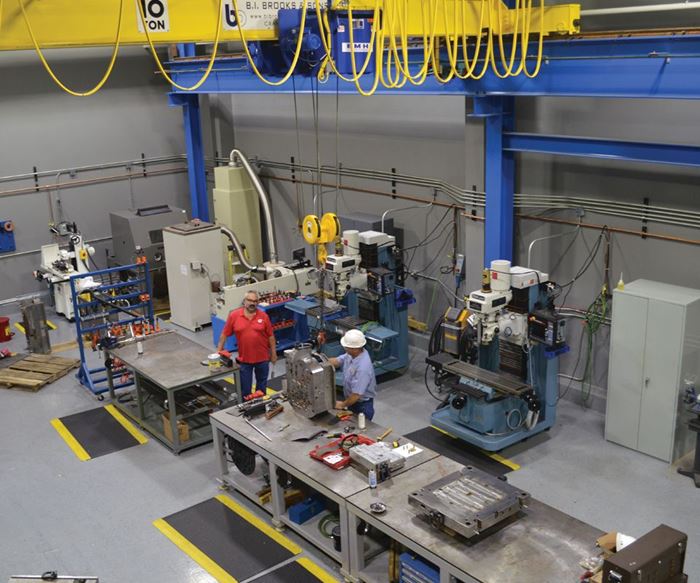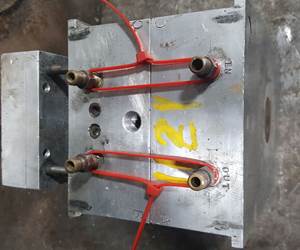Tool Maintenance: A Molder’s Must-Have
Equipping a toolroom for proper mold maintenance and repair takes more than just the right technology.
As it expanded its molding operations, Henkel realized it would need to add more than molding machines—namely, a toolroom.
Robert Gattshall has been in injection molding long enough to know a skilled toolmaker is a molder’s best friend. When job No. 1 is running quality parts, and you know that isn’t possible without a functioning, well-maintained tool, you begin to appreciate just how important it is to have a moldmaker on staff.
In April 2014, Greg Krueger, director of operations for Henkel’s Richmond, Missouri, site, recruited Gattshall to manage the engineering group for the Adhesive Technologies operation of the German conglomerate. Krueger’s big-picture plan was to establish an in-house toolroom, and bringing in Gattshall was just the beginning. As new products began launching, the absence of a toolroom became more and more problematic for the plant, which specializes in making bonding, sealing and surface treatments.
When it initially ramped up injection, Henkel outsourced tool maintenance to Chicago-area moldmakers that were more than 500 miles and seven-plus hours away. “It was identified that there was no way we could continue to do business having all those tools trucked to Chicago for repairs,” Gattshall says. Back then, it could take five days just to ship a mold to Chicago for maintenance, given the size of some of the tools Henkel deals with.
A New Blueprint
Converted from an old storage space, the toolroom went live in January 2016. It was designed by Gattshall and journeyman moldmaker Craig Linhart, who was hired in April 2015. Henkel Richmond continues to round out the toolroom staff with the addition of five full-time employees and plans for eight total in the near future.
The changes at Henkel Richmond are new enough that a blueprint of the plant floor’s altered layout still hangs on Gattshall’s office wall. Green, blue and black markings denote where storage would become molding bays and where the new toolroom would be carved out. Next to that is a schematic of the newly realized toolroom. On the top of the 8-by-11-inch black-and-white sheet is a design layout, while below it equipment is listed by “item,” “quantity” and “voltage/amperage.”
“We didn’t just put in a toolroom,” Gattshall says, “we put in a state-of-the-art toolroom.” Equipment on the floor in the newly refurbished space includes grinders, mills, lathes, EDMs, drill presses and a laser welder, while a new 10-ton overhead crane looks down from above.
Putting in a Preventive Maintenance Program
Adding the requisite equipment is just the first step in creating an in-house tool-maintenance program. The next is to form a program that occupies that equipment, and the individuals running it, in the most efficient manner possible. The addition of the toolroom coincided nicely with Henkel’s bid to change its manufacturing culture from one of fixing the symptoms of faulty processes and equipment, to fixing the faulty process or equipment.
In the past, confronted by flash, for example, the company would assign a worker to trim it or alter the process to try to make it go away. Today, empowered workers make a decision based on a troubleshooting checklist that isolates the root cause as being related to process or tooling, or the machine.
“Our troubleshooting checklist doesn’t have things on it like, ‘If you’ve got shorts or flash, here’s the process change you make,’” Gattshall says. “None of that.” Once the protocol has been followed and it has been determined that the validated process hasn’t been altered, a conclusion is reached. “Then we would have to make a business decision on whether or not we can take the tool out of production immediately, but most of the time we do, and we take it to our new toolroom where we have the ability to fix the issue.”
Finding the PM Sweet Spot
To keep tools from degrading to the point of flash, Henkel has also put in place a preventive maintenance (PM) program. At this time, it’s based on the number of cycles, but it, too, will evolve. After approximately 50,000 shots, Henkel’s toolroom will bring in a mold for a complete inspection. What happens before the next 50,000 shots depends. “If a tool doesn’t make it to 50,000 shots, the preventative maintenance frequency is too long,” Gattshall says. If at 50,000 shots, you tear the mold apart, start looking at the components and everything is clean as a whistle, you know that you can extend the preventative maintenance on that tool.”
The sweet spot lies somewhere in between and depends on a variety of factors, including the mold’s cavitation, the part’s design and the material being run. “We don’t want to do preventative maintenance on a tool if it’s not required,” he says, “and we want to make sure we’re doing more preventative maintenance if it is.”
Even further down the line, he says the goal is to have its production monitoring system from Northhamptonshire, UK-based Intouch Monitoring Ltd. trigger when maintenance is
required. But beyond a cycle counter or process-
monitoring software, Gattshall emphasizes that Henkel’s operators are most important to its maintenance program.
“Our operators might not be plastics experts, but they’re the process experts, because they run these tools every single day,” he says. “We rely on them with this troubleshooting checklist, and we actually empower them to make a decision.”
Valuing Onsite Tool Maintenance
Gattshall says the toolroom continues to ramp up and, despite only opening at the start of the year, its impact has already been felt on the company’s bottom line. He credits Krueger with having the vision to see the impact it would have before a single grinder was installed. Krueger’s background might explain why he made the choice: “Greg Krueger was a toolmaker—a tooling engineer,” Gattshall says. “He understands the value of having onsite tool maintenance.”
Related Content
What You Should Know About Injection Mold Safety Straps
Every mold should have one in order to be safe and OSHA compliant.
Read MoreHands-on Workshop Teaches Mold Maintenance Process
Intensive workshop teaches the process of mold maintenance to help put an end to the firefighting culture of many toolrooms.
Read MoreHow to Overcome Complex Mold Texturing Problems
Key benefits when considering laser technology for mold texturing and repair.
Read MoreQuestions and Considerations Before Sending Your Mold Out for Service
Communication is essential for proper polishing, hot runner manifold cleaning, mold repair, laser engraving and laser welding services.
Read MoreRead Next
Reasons to Use Fiber Lasers for Mold Cleaning
Fiber lasers offer a simplicity, speed, control and portability, minimizing mold cleaning risks.
Read MoreHow to Use Continuing Education to Remain Competitive in Moldmaking
Continued training helps moldmakers make tooling decisions and properly use the latest cutting tool to efficiently machine high-quality molds.
Read MoreHow to Use Strategic Planning Tools, Data to Manage the Human Side of Business
Q&A with Marion Wells, MMT EAB member and founder of Human Asset Management.
Read More























